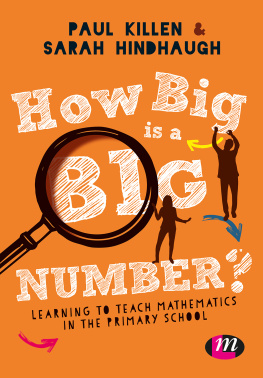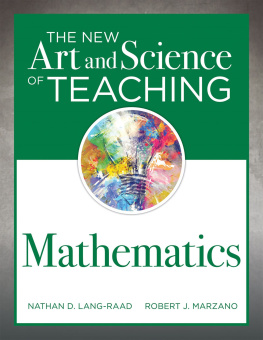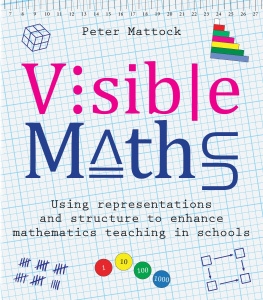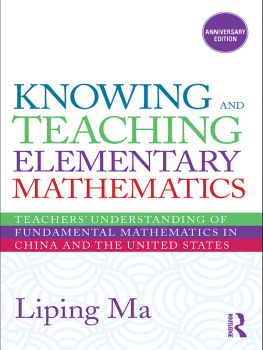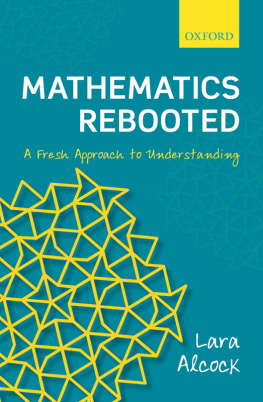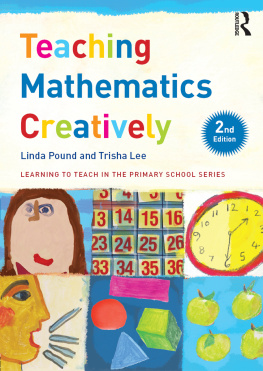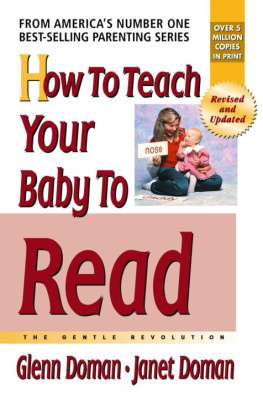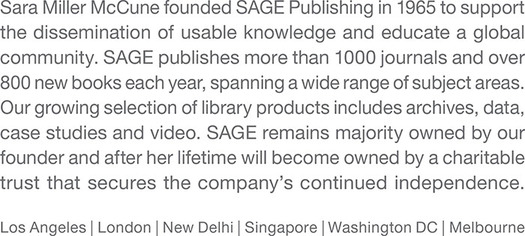This book is dedicated to the many wonderful primary trainees we have met and taught over the past years at LJMU. We have learned so much from you and we hope you have learned something from us.
About the authors
Paul Killen After previously working in secondary schools, Further Education and Higher Education,
Paul Killen is now Head of Primary Programmes at Liverpool John Moores University and over almost 20 years has taught primary and secondary mathematics education to a vast range of Initial Teacher Training (ITT) courses including PGCE, Undergraduate and School Direct. Paul was also Programme Leader for Teach First in Liverpool and for 7 years delivered mathematics at the Teach First Summer Institutes in Canterbury, Warwick and Leeds.Sarah Hindhaugh began her career teaching in primary schools where she became a school mathematics coordinator and a lead mathematics teacher for Liverpool Education Authority. For the last 17 years she has been a Senior Lecturer in mathematics at Liverpool John Moores University where she manages the mathematics provision across all ITT routes including undergraduate and postgraduate courses.
Introduction
We are passionate about mathematics. We love maths and we love teaching maths.
As such, it upsets us greatly to hear adults say, I cant do maths or I hate maths. It is even worse to hear children make such comments. We believe that through effective teaching, every child has the potential to achieve a high level of mathematical proficiency. We go further. Anyone with a negative mathematical outlook has been failed by their teachers.
Mastery of mathematics is an issue currently high on the education agenda. However, to be able to deliver mastery, teachers need to not only be confident in their curriculum subject knowledge, they must also have a deep understanding of the pedagogical knowledge that will allow any mathematical topic to be taught in the most effective way.
It is our belief that many of us were taught mathematics by being provided with a range of, what we call, rules and their recipes. Very often, such rules were not explained or justified. We want all students and all children to fully understand what they are doing in mathematics and why they are doing it. A mastery approach in mathematics avoids teaching children rules and it presents all new work in the context of childrens existing knowledge.
This book seeks to bring together these three elements of mastery, curriculum knowledge and pedagogy. We trust that by reading this book you will become more secure in your own mathematical understanding and will therefore become a more effective teacher. In the same way that children will deepen their understanding of mathematics by doing it, you will develop your mastery of pedagogy through teaching it.
It has been our pleasure to teach students how to teach mathematics for many years and it is they who have inspired us to write this book. We know that many of our students began their training lacking confidence in their own ability at mathematics. Yet time and again, we have seen them blossom into highly effective teachers with a desire to ensure all children achieve mathematical success.
Contained within each chapter of this book, we offer teaching ideas, as well as opportunities for you to reflect on various aspects of mathematical knowledge and pedagogy. We also include tasks for you to complete in each chapter. There are two types of task: the first type provides you with the opportunity to work through some specific examples related to each theme in the appendix, we provide the solutions to these. However, this is not a mathematics textbook. Rather, we want you to think how each mathematical idea we discuss can be developed in the classroom to promote mastery. Thus, the second type of task we include is designed to offer ideas to stretch and challenge both you and the children in your class.
What maths can you see?
The key to mastering any mathematical topic and its corresponding skills is to be able to apply the new knowledge in a variety of different contexts. Equally, children need to be able to recognise the mathematics in various problems and situations. With this in mind, we will conclude each chapter with a photograph.
For the reader, this is an opportunity to think of the application of mathematics in a wide range of situations. Each image could also be used as a stimulating starter activity with a group of children. For each photograph, we simply invite you to identify, What maths can you see? Sometimes the mathematics is obvious and links directly to elements covered in that chapter. However, sometimes the mathematics is less clear.
Each photograph has the potential to lead to a rich discussion about the mathematics that is all around us and to apply mathematical thinking to a real-life context. We believe that it is through such discussion that children will master different mathematical ideas. There is no right or wrong way to approach this. The teacher will lead this discussion through a series of open questions and children may see connections with aspects of mathematics that you do not. In the appendix to this book, we offer some guidance and possible avenues to explore in relation to each photograph.

